Representative Environmental Condition for Fatigue Analysis of Offshore Jacket Substructure
Abstract
1. Introduction
2. Fatigue Life Assessment
2.1. Numerical Model of Jacket Substructure
2.2. Fatigue Damage Assessment
3. Long-Term Metocean Statistics
3.1. Wave Scatter Diagram
3.2. Cumulative Fatigue Damage
3.3. Representative Selection Method
- (1)
- Probability type (Pr): the algorithm of the probability type is selected on the basis of the rank of probability when the probability distribution is monotonically decreasing. This method can mitigate the problem caused by local peaks in the probability distribution of the raw statistics. The total number M of selected sea states is denoted Pr-M in the following discussion—for example, Pr-6 and Pr-9. Since high waves contribute to higher damage, the sea states with a lower wave height than the sea states at the most probable sea state Pmax are omitted, denoted Pr-6U and Pr-9U. Moreover, when the same probability occurs in the same wave period, the condition of higher wave height should be selected. When the same probability occurs at the same wave height, the condition of the smaller wave period should be selected. The numbers in Figure 9a are ranked according to the probability and the figure displays the selected range of environmental conditions in the Metocean 5. The selected sea states are detailed in Appendix C.
- (2)
- Neighborhood type (Nb): this method also starts from the most probable sea state and only selects its neighbor sea states. The extended left side is expected to obtain a larger damage value because of the shorter wave period. The extended right side is expected to have a larger probability, because the wave height value and the wave period value reveal a positive correlation [21]. Therefore, the combination of neighborhood sea states could be Nb-6, extending one more level of wave height than that of Pmax. We can widen the range to include three rows, making M = 9. Nb-9 locates Pmax at the center, as per Figure 9b, and Nb-9U shifts one row upward by one level of wave height, as in Figure 9c. The purple frame presents Nb-9U, and the blue frame shows Nb-9. The selection for other metoceans is presented in Appendix C in this paper.
4. Discussion
4.1. Most Probable Sea State
4.2. Selection by Neighborhood
4.3. Selection by Probability
4.4. Extrapolation of Unresolved Sea States
5. Conclusions
Author Contributions
Funding
Conflicts of Interest
Appendix A
| Section | Diameter (m) | Thickness (mm) |
|---|---|---|
| Pile | 2.08 | 60 |
| Lower leg | 1.2 | 50 |
| Upper leg | 1.2 | 35 |
| Brace | 0.8 | 20 |
| Tower | 5.6–4.1 (tapered) | 32–20 |
Appendix B





Appendix C
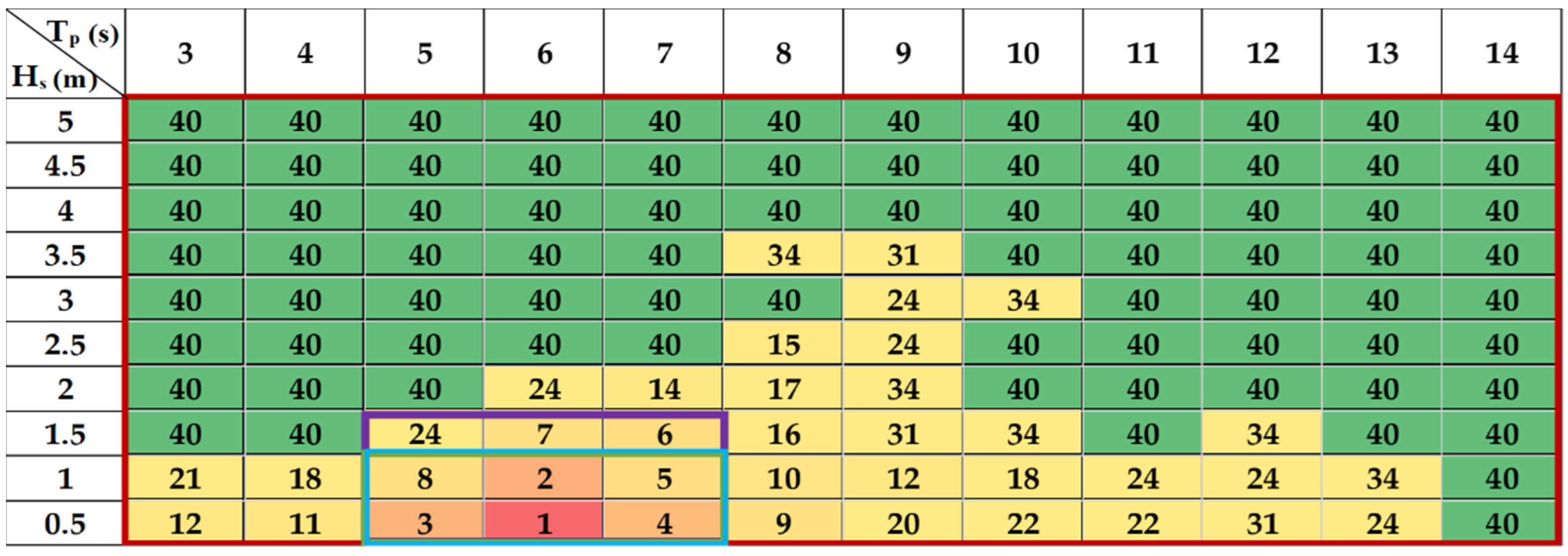
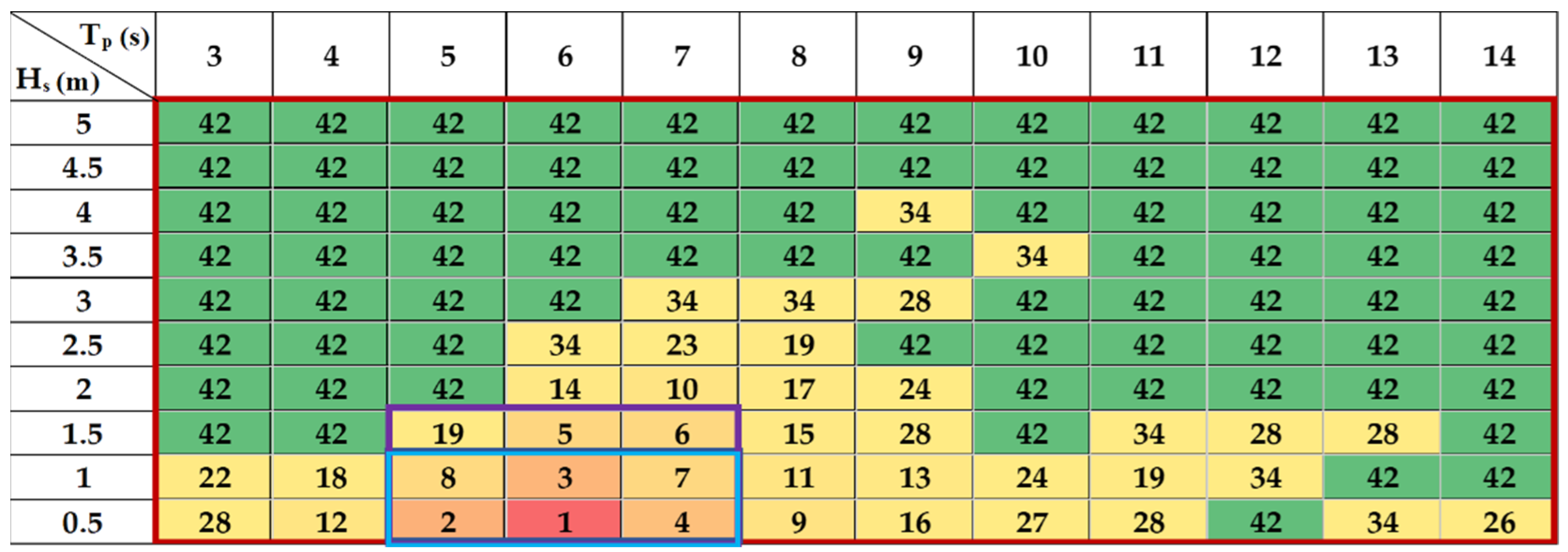
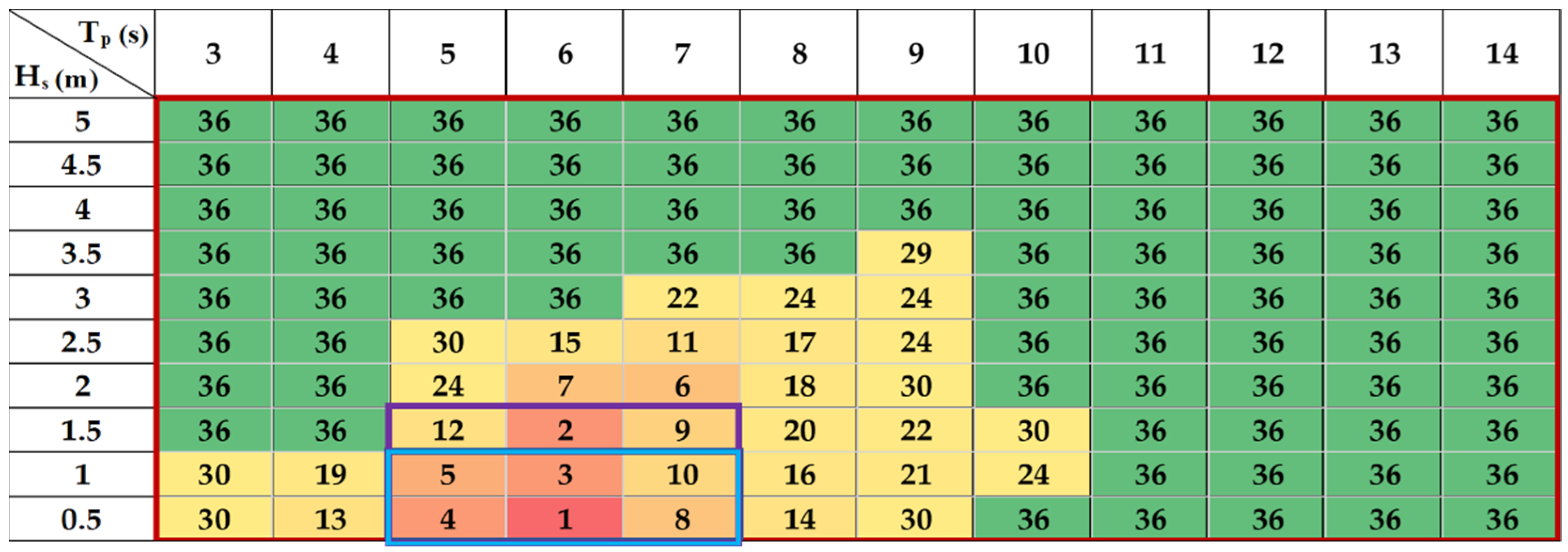
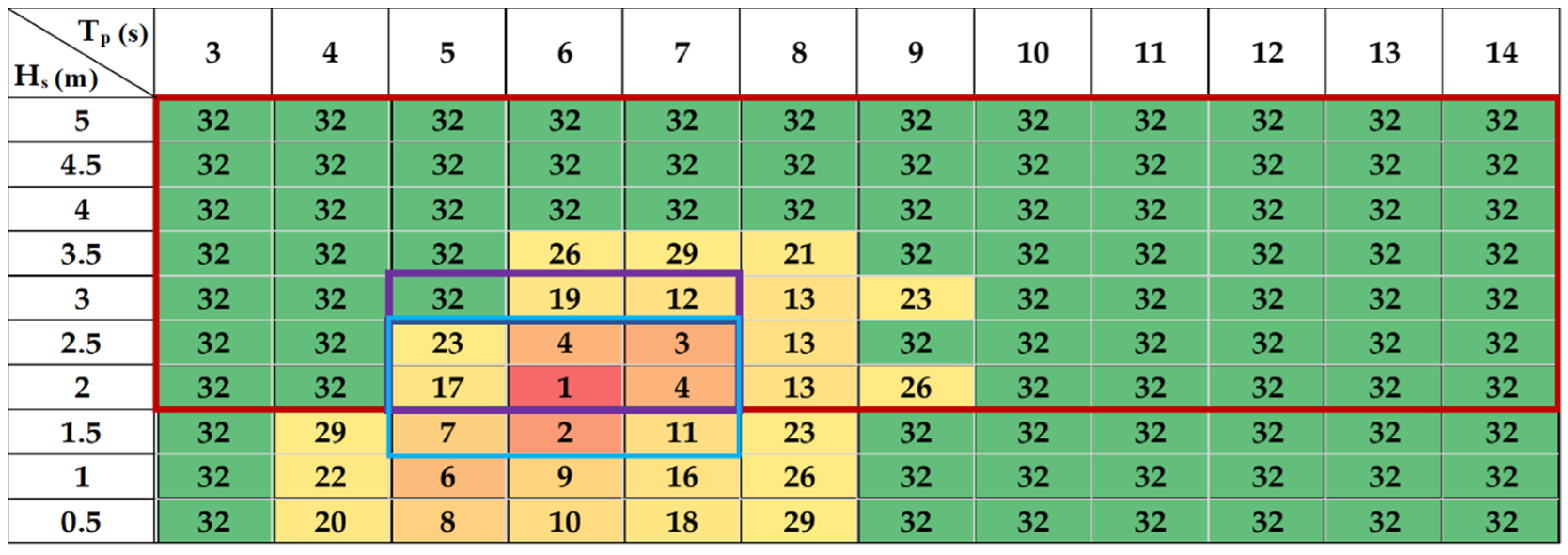
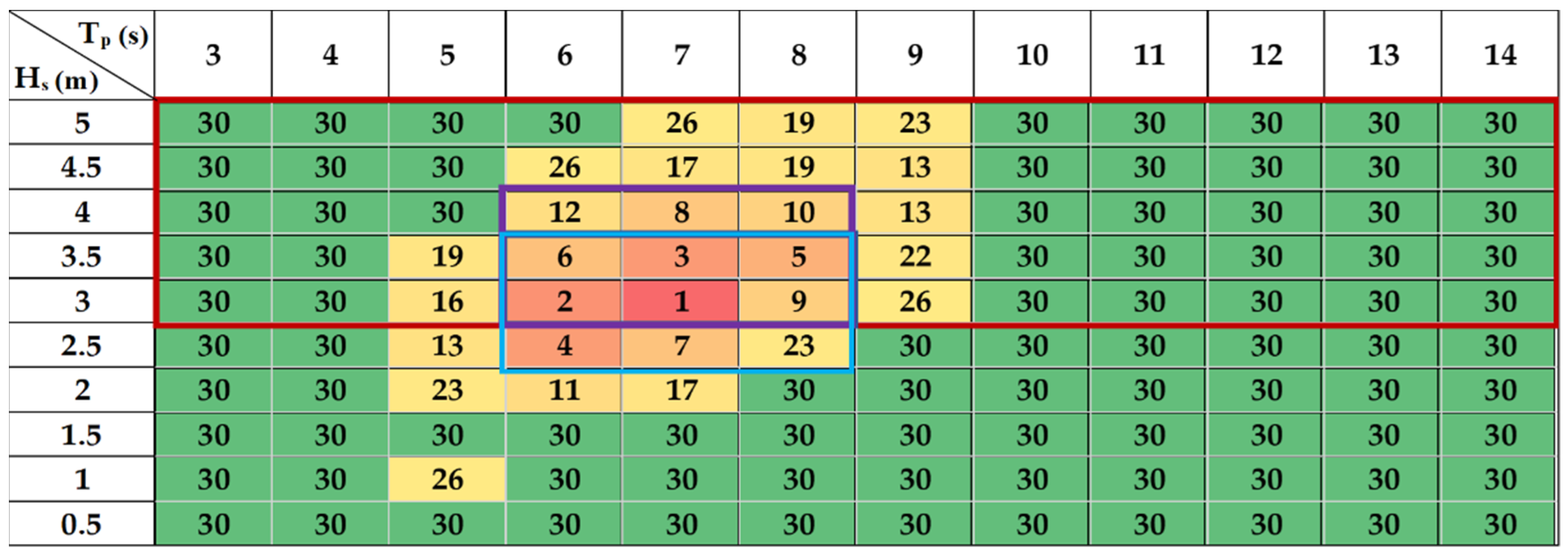
References
- Renewables Energy Policy Network for the 21st Century. Renewables 2020 Global Status Report; REN21: Paris, France, 2020; Available online: https://www.ren21.net/gsr-2020/ (accessed on 22 August 2020).
- Global Wind Power: 2017 Market and Outlook to 2022. In Global Wind Energy Council; Power & Energy Solutions Wind, England and Wales. 2017. Available online: http://cdn.pes.eu.com/v/20160826/wp-content/uploads/2018/06/PES-W-2-18-GWEC-PES-Essential-1.pdf. (accessed on 29 February 2020).
- Ciang, C.C.; Lee, J.R.; Bang, H.J. Structural health monitoring for a wind turbine system: A review of damage detection methods. Meas. Sci. Technol. 2008, 19, 122001. [Google Scholar] [CrossRef]
- Dong, W.; Moan, T.; Gao, Z.J.E.S. Long-term fatigue analysis of multi-planar tubular joints for jacket-type offshore wind turbine in time domain. Eng. Struct. 2011, 33, 2002–2014. [Google Scholar] [CrossRef]
- Yeter, B.; Garbatov, Y.; Guedes Soares, C. Fatigue damage assessment of fixed offshore wind turbine tripod support structures. Eng. Struct. 2015, 101, 518–528. [Google Scholar] [CrossRef]
- Kim, H.J.; Jang, B.S.; Park, C.K.; Bae, Y.H. Fatigue analysis of floating wind turbine support structure applying modified stress transfer function by artificial neural network. Ocean Eng. 2018, 149, 113–126. [Google Scholar] [CrossRef]
- Zhao, P.Y.; Huang, X.P. An improved spectral analysis method for fatigue damage assessment of details in liquid cargo tanks. China Ocean Eng. 2018, 32, 62–73. [Google Scholar] [CrossRef]
- Yeter, B.; Garbatov, Y. Spectral fatigue assessment of an offshore wind turbine structure under wave and wind loading. In Developments in Maritime Transportation and Exploitation of Sea Resources; Francis & Taylor Group: London, UK, 2013; pp. 425–433. [Google Scholar]
- Van Der Tempel, J. Design of Support Structures for Offshore Wind Turbines. Ph.D. Thesis, Technische Universiteit Delft, Delft, The Netherlands, 2006. [Google Scholar]
- Chian, C.Y.; Zhao, Y.Q.; Lin, T.Y.; Nelson, B.; Huang, H.H. Comparative study of time-domain fatigue assessments for an offshore wind turbine jacket substructure by using conventional grid-based and Monte Carlo sampling methods. Energies 2018, 11, 3112. [Google Scholar] [CrossRef]
- Baarholm, G.S.; Moan, T. Estimation of nonlinear long-term extremes of hull girder loads in ships. Mar. Struct. 2000, 13, 495–516. [Google Scholar] [CrossRef]
- Chen, I.W.; Wong, B.L.; Lin, Y.H.; Chau, S.W.; Huang, H.H. Design and analysis of jacket substructures for offshore wind turbines. Energies 2016, 9, 264. [Google Scholar] [CrossRef]
- Vorpahl, F.; Popko, W.; Kaufer, D. Description of a Basic Model of the "Upwind Reference Jacket” for Code Comparison in the OC4 Project under IEA Wind Annex XXX; Fraunhofer Institute for Wind Energy and Energy System Technology (IWES): Bremerhaven, Germany, 2011. [Google Scholar]
- International Standard IEC 61400-3. Wind Turbines—Part 3: Design Requirements for Offshore Wind Turbines; International Electrotechnical Commission (IEC): London, UK, 2009. [Google Scholar]
- Bai, Y.; Jin, W.L. Marine Structural Design, 2nd ed.; Butterworth-Heinemann: Oxford, UK, 2015. [Google Scholar]
- Det Norske Veritas and Germanischer Lloyd (DNVGL). Fatigue Design of Offshore Steel Structures; DNVGL-RP-C203; DNVGL: Oslo, Norway, 2016. [Google Scholar]
- Dirlik, T. Application of Computers in Fatigue Analysis. Ph.D. Thesis, University of Warwick, Coventry, UK, 1985. [Google Scholar]
- Sherratt, F.; Bishop, N.W.M.; Dirlik, T. Predicting fatigue life from frequency-domain data: Current methods. J. Eng. Integr. Soc. 2005, 18, 12–16. [Google Scholar]
- Miner, M.A. Cumulative Damage in Fatigue. J. Appl. Mech. 1945, 12, 159–164. [Google Scholar]
- Morison, J.R.; O’Brien, M.P.; Johnson, J.W.; Shaaf, S.A. The forces exerted by surface waves on monopiles. J. Pet. Technol. 1950, 2, 149–154. [Google Scholar] [CrossRef]
- Vanem, E. Joint statistical models for significant wave height and wave period in a changing climate. Mar. Struct. 2016, 49, 180–205. [Google Scholar] [CrossRef]
- Jonkman, J.; Butterfield, S.; Musial, W.; Scott, G. Definition of a 5-MW Reference Wind Turbine for Offshore System Development; National Renewable Energy Lab. (NREL): Golden, CO, USA, 2009.
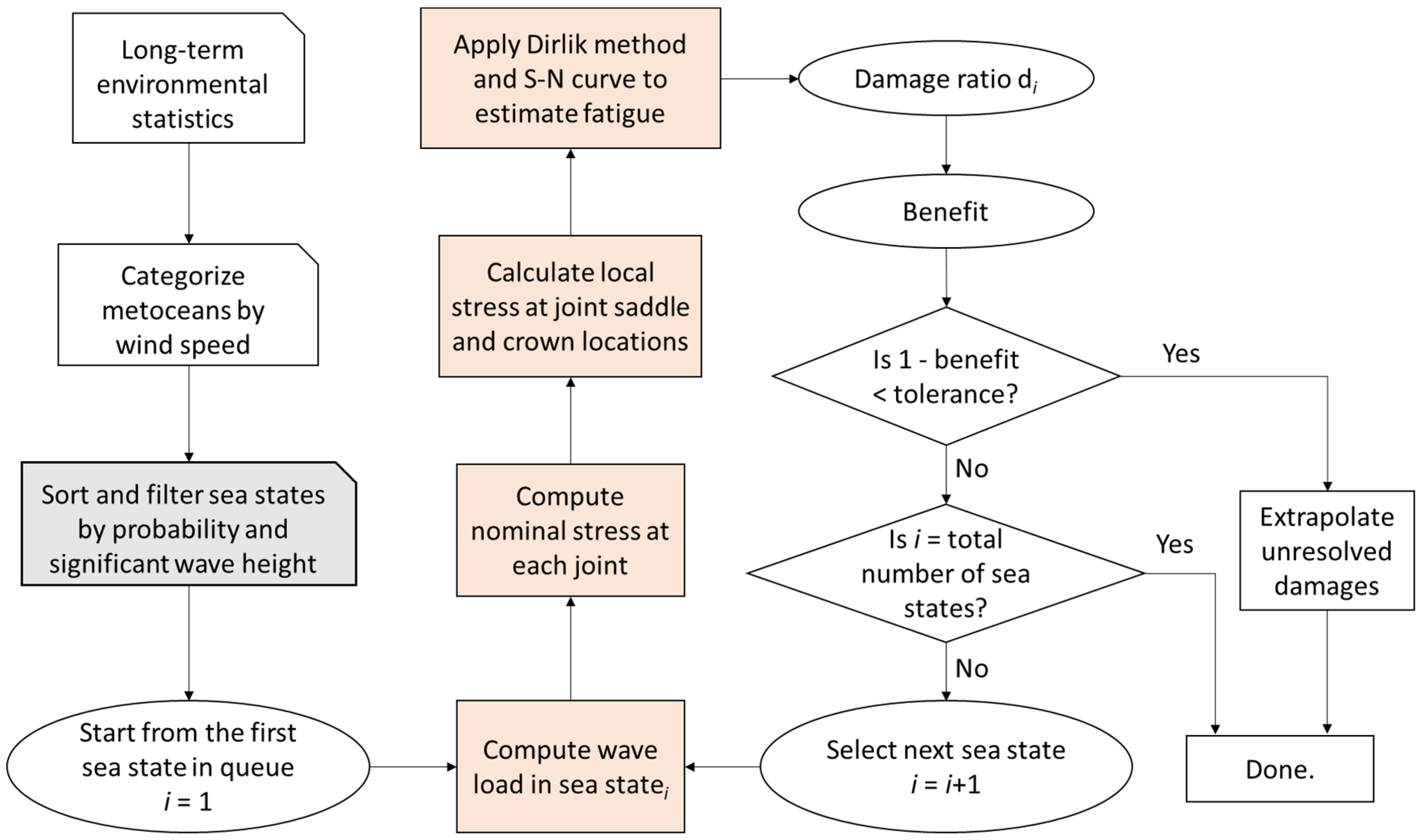
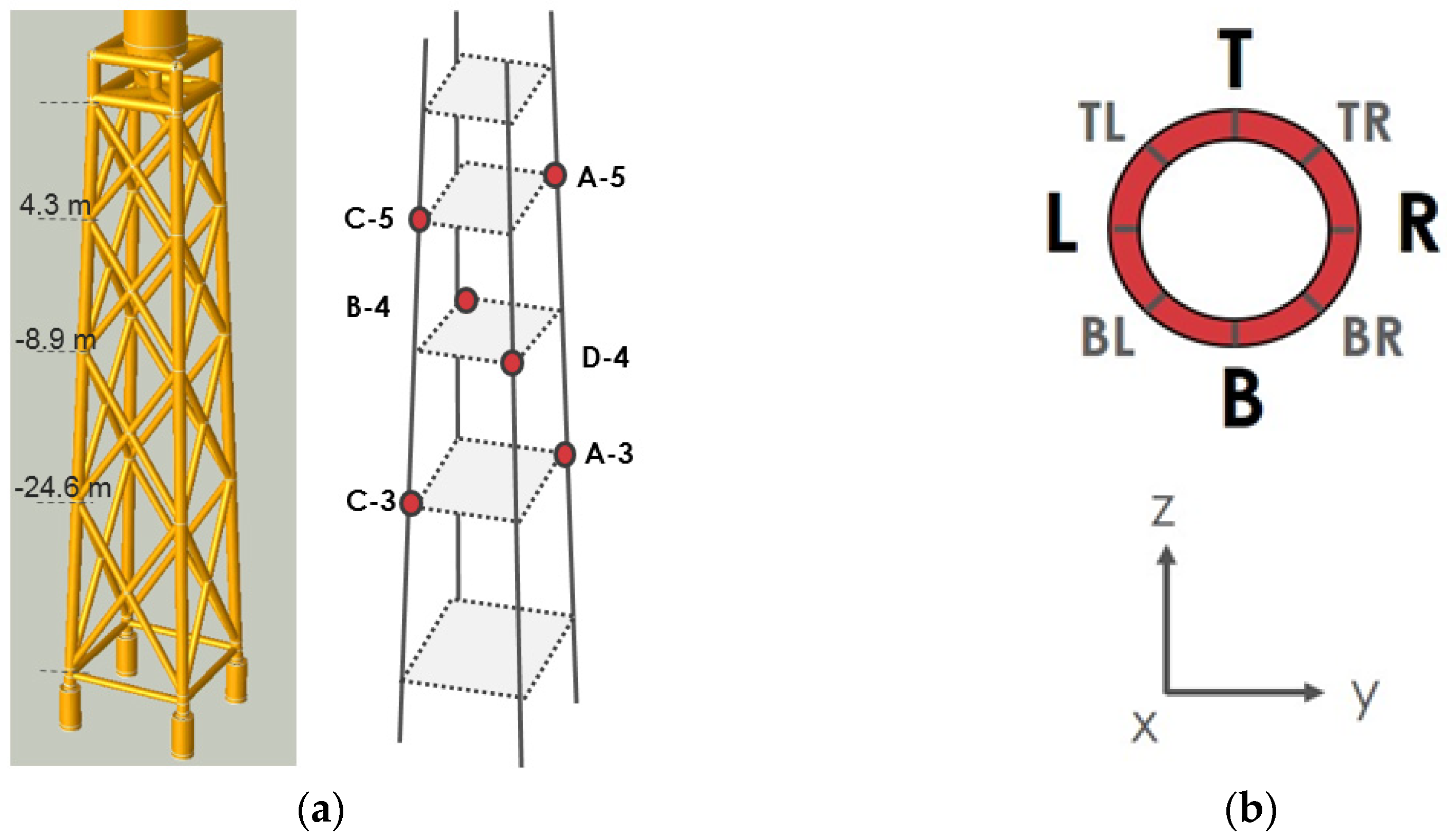
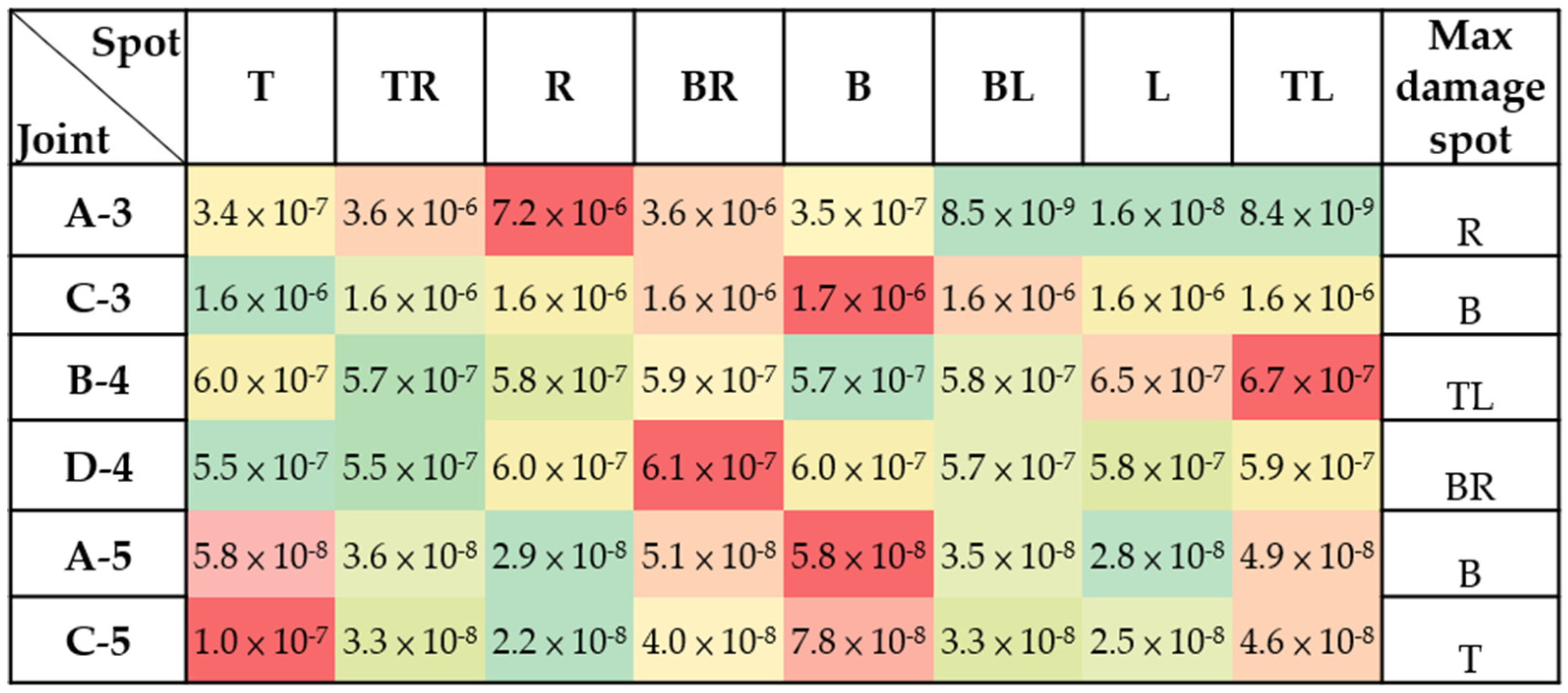
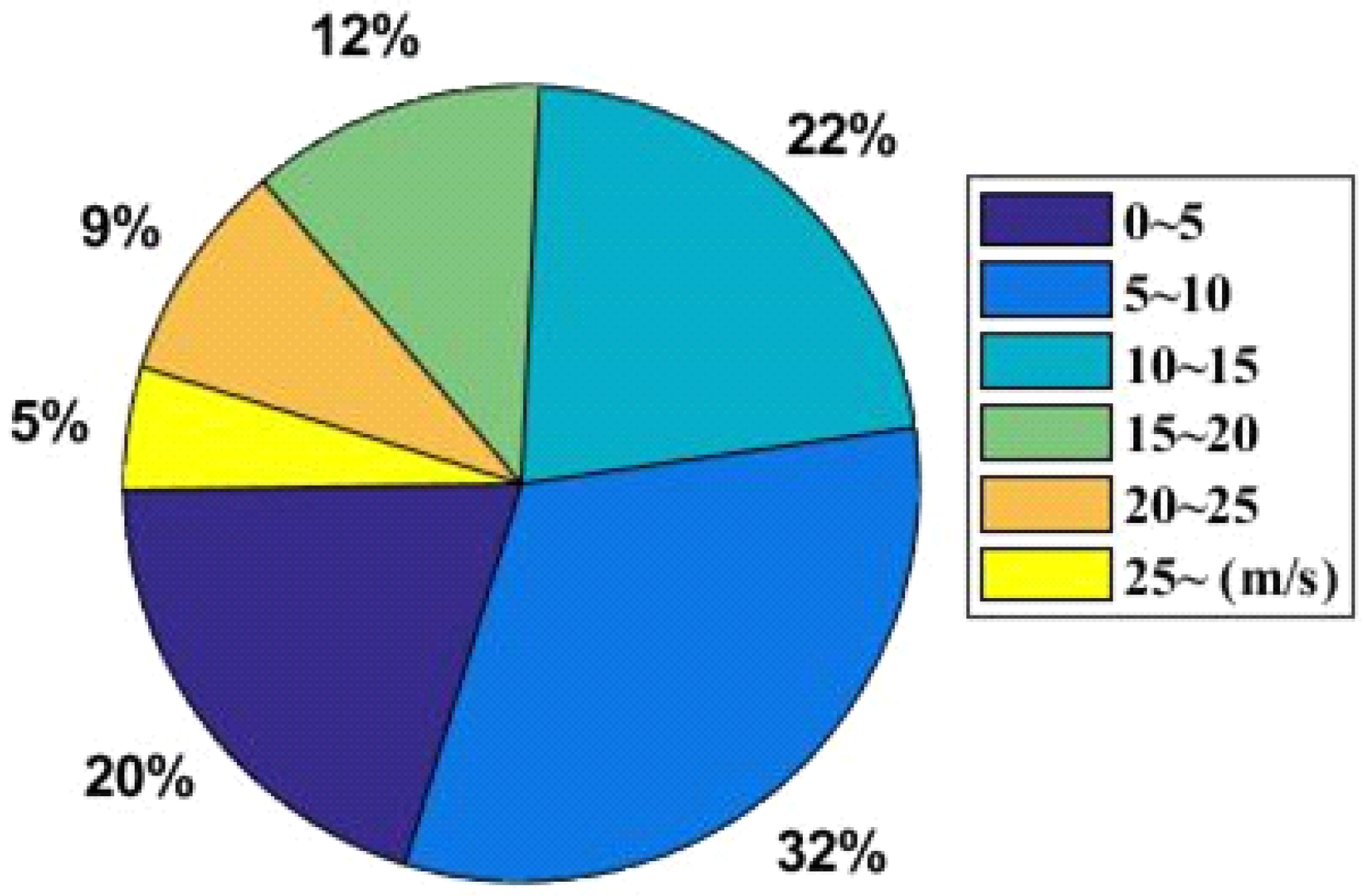
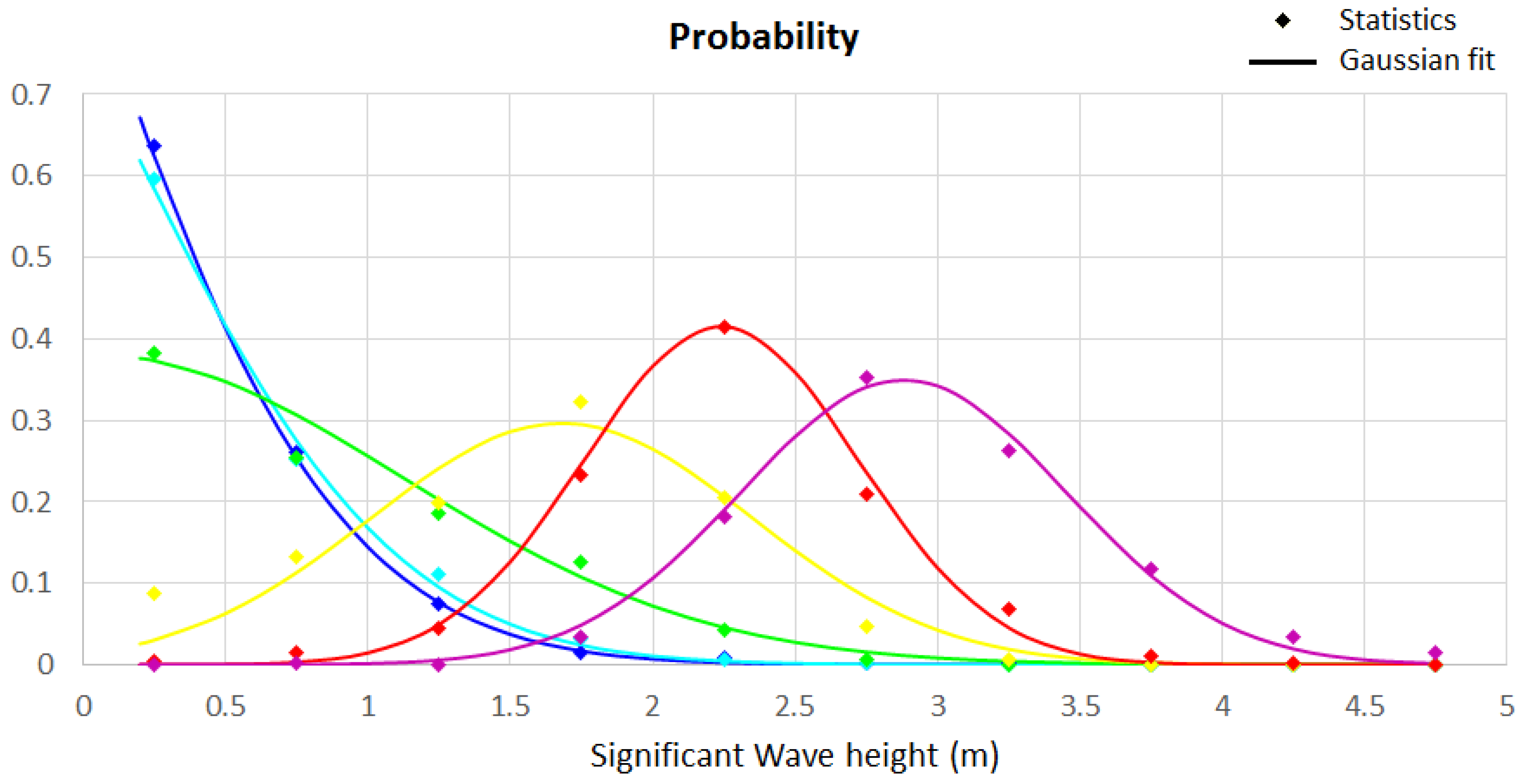

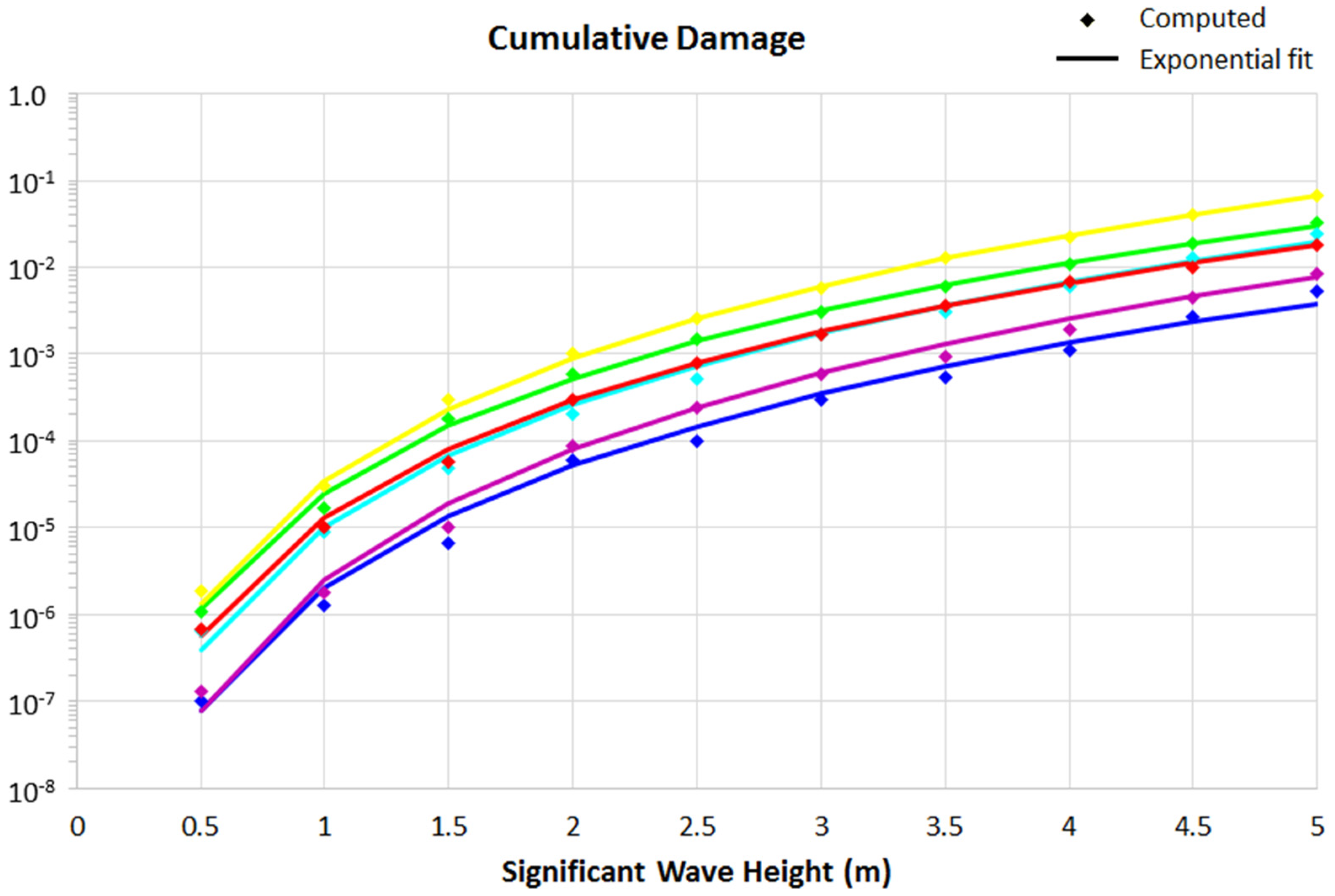
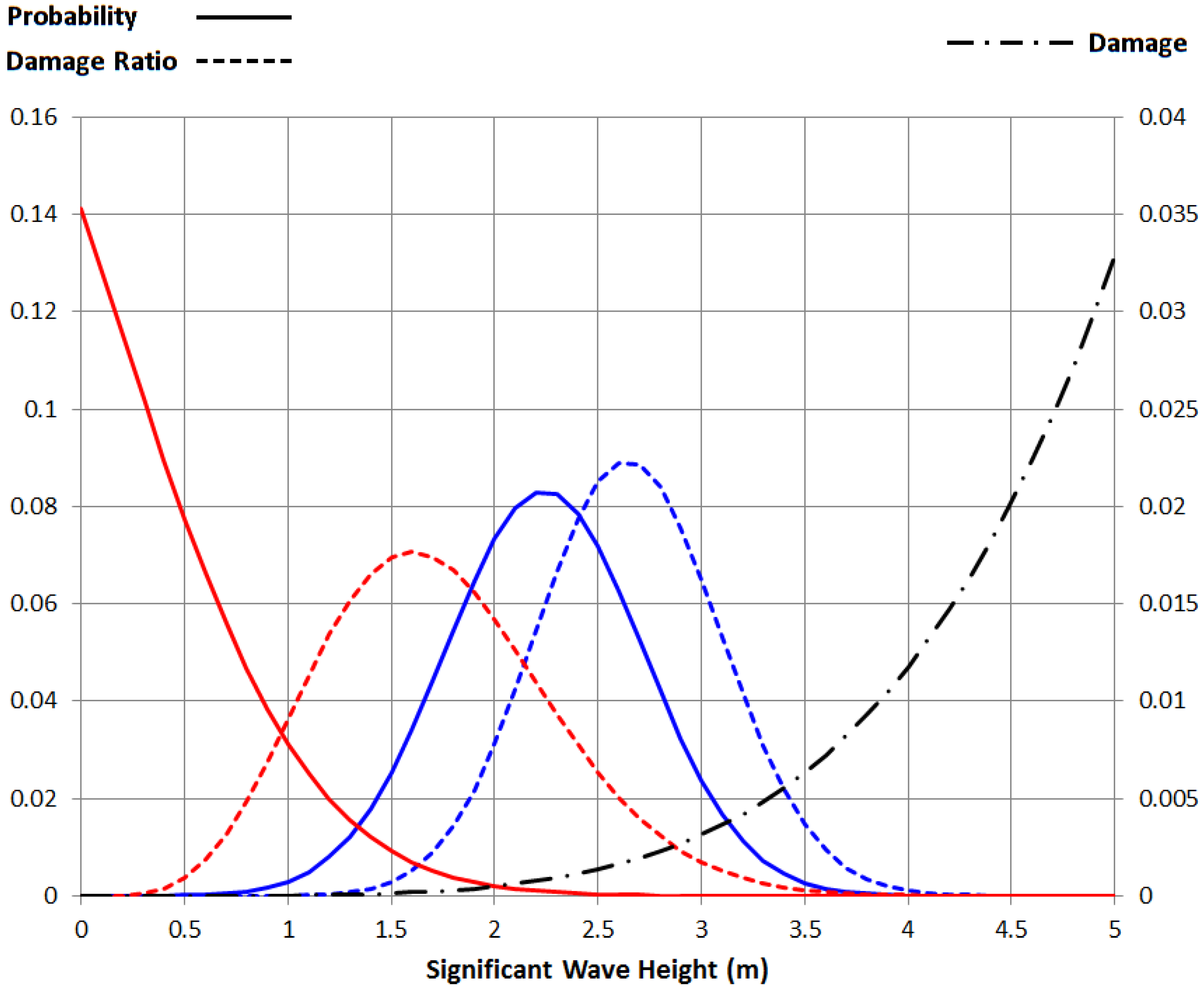
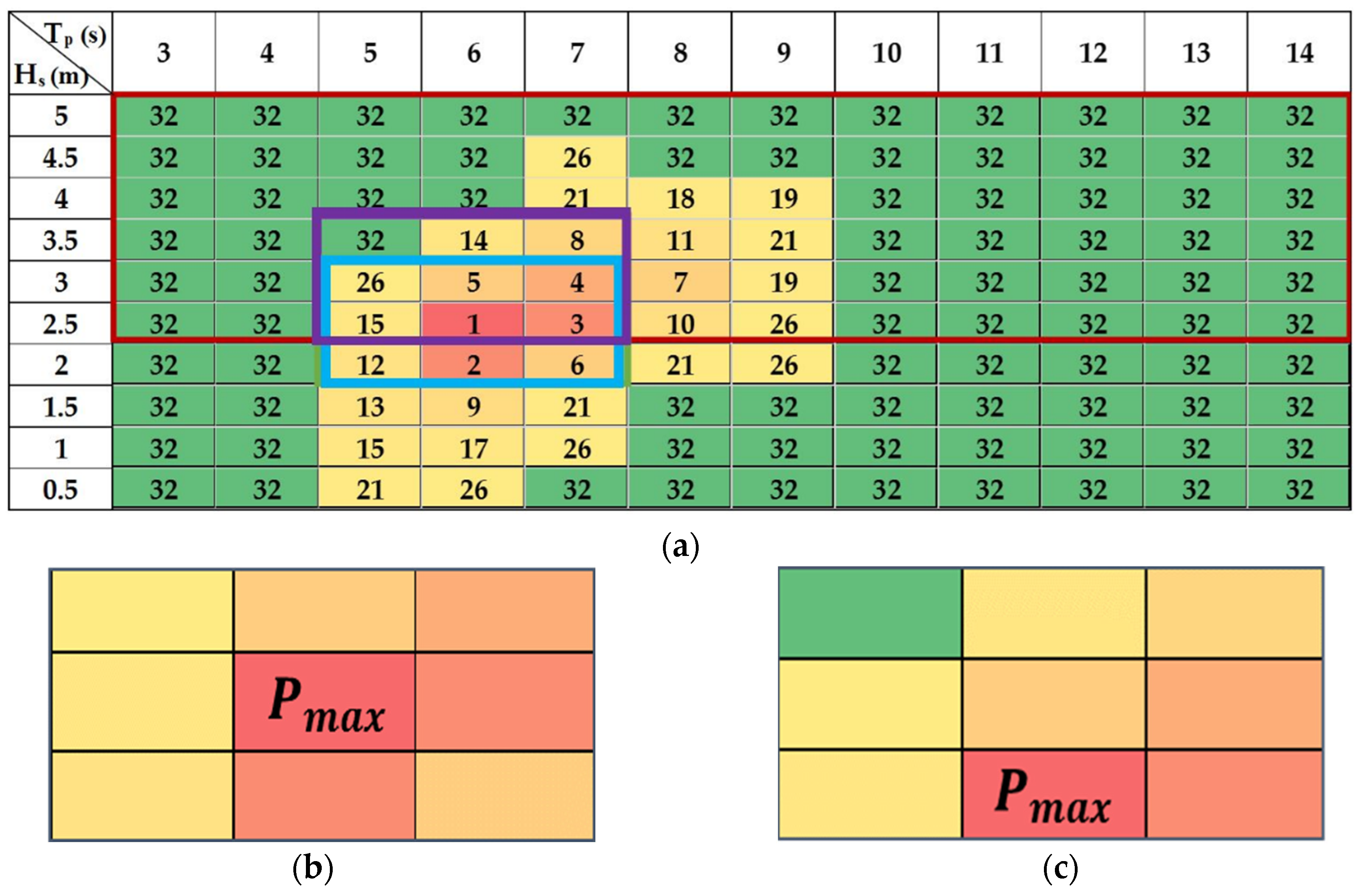
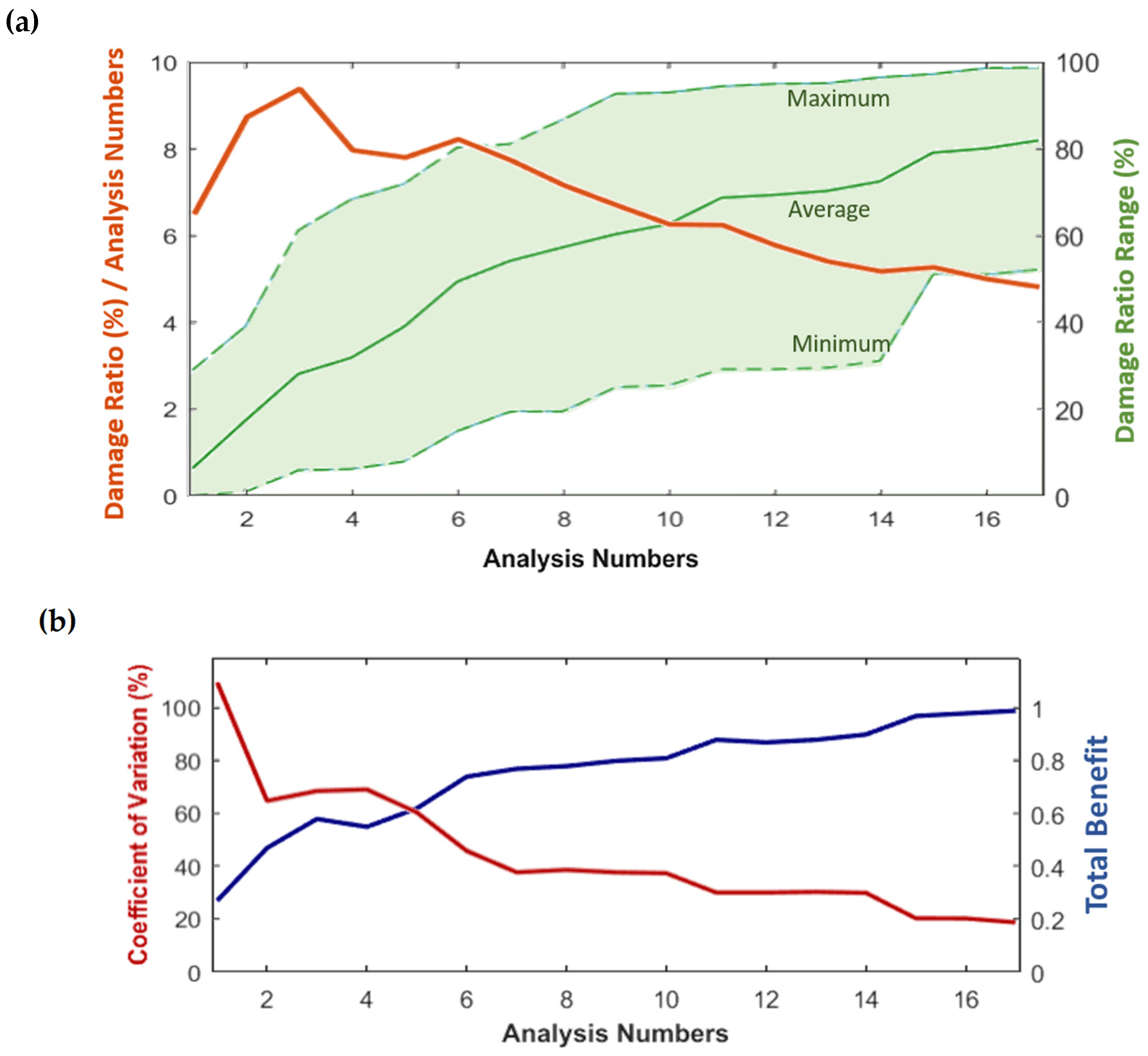

| Metocean | 1 | 2 | 3 | 4 | 5 | 6 |
|---|---|---|---|---|---|---|
| Wind speed (m/s) | 0–5 | 5–10 | 10–15 | 15–20 | 20–25 | 25+ |
| Wave height (m) | 0.5 | 0.5 | 0.5 | 2.0 | 2.5 | 3.0 |
| Wave period (s) | 6 | 6 | 6 | 6 | 6 | 7 |
| Highest Probability | 32% | 30% | 18% | 20% | 22% | 17% |
| Metocean | 1 | 2 | 3 | 4 | 5 | 6 | |
|---|---|---|---|---|---|---|---|
| Wind speed (m/s) | 0–5 | 5–10 | 10–15 | 15–20 | 20–25 | 25+ | |
| Significant wave height (m) | 5 | 0.0 | 0.0 | 0.0 | 0.0 | 0.0 | 1.4 |
| 4.5 | 0.0 | 0.0 | 0.0 | 0.0 | 0.1 | 3.5 | |
| 4 | 0.0 | 0.0 | 0.0 | 0.0 | 1.1 | 11.7 | |
| 3.5 | 0.2 | 0.0 | 0.1 | 0.7 | 6.8 | 26.3 | |
| 3 | 0.2 | 0.1 | 0.6 | 4.6 | 20.9 | 35.2 | |
| 2.5 | 0.8 | 0.6 | 4.3 | 20.5 | 41.5 | 18.1 | |
| 2 | 1.6 | 3.3 | 12.7 | 32.2 | 23.2 | 3.5 | |
| 1.5 | 7.5 | 11.1 | 18.6 | 19.9 | 4.5 | 0.0 | |
| 1 | 26.0 | 25.3 | 25.4 | 13.3 | 1.5 | 0.2 | |
| 0.5 | 63.7 | 59.5 | 38.3 | 8.7 | 0.4 | 0.0 | |
| Gaussian Fit—Mean | −0.99 | −0.72 | 0.05 | 1.68 | 2.24 | 2.88 | |
| Gaussian Fit—SD | 0.91 | 0.9 | 1.07 | 0.67 | 0.48 | 0.57 | |
| Joint | Multiplier f | Exponent α*m |
|---|---|---|
| A-3 | 2.5 × 10−5 | 4.4 |
| C-3 | 3.5 × 10−5 | 4.7 |
| B-4 | 1.3 × 10−5 | 4.5 |
| D-4 | 1.0 × 10−5 | 4.7 |
| A-5 | 2.5 × 10−6 | 5.0 |
| C-5 | 2.0 × 10−6 | 4.7 |
| Metocean | 1 | 2 | 3 | 4 | 5 | 6 |
|---|---|---|---|---|---|---|
| A-3 | 4.6 × 10−5 | 4.1 × 10−5 | 1.2 × 10−4 | 5.1 × 10−4 | 1.8 × 10−3 | 5.3 × 10−3 |
| C-3 | 7.4 × 10−5 | 6.7 × 10−5 | 2.0 × 10−4 | 8.8 × 10−4 | 3.1 × 10−3 | 9.4 × 10−3 |
| B-4 | 2.0 × 10−5 | 2.0 × 10−5 | 6.3 × 10−5 | 2.8 × 10−4 | 9.5 × 10−4 | 2.8 × 10−3 |
| D-4 | 2.1 × 10−5 | 2.1 × 10−5 | 6.7 × 10−5 | 3.0 × 10−4 | 1.0 × 10−3 | 3.1 × 10−3 |
| A-5 | 1.4 × 10−6 | 1.5 × 10−6 | 5.2 × 10−6 | 2.5 × 10−5 | 8.1 × 10−5 | 2.4 × 10−4 |
| C-5 | 9.6 × 10−7 | 1.1 × 10−6 | 3.6 × 10−6 | 1.7 × 10−5 | 5.3 × 10−5 | 1.4 × 10−4 |
| Metocean | 1 | 2 | 3 | 4 | 5 | 6 | |
|---|---|---|---|---|---|---|---|
| Damage ratio at joint (%) | A-3 | 5.1 | 5.4 | 1.1 | 4.1 | 14.9 | 10.4 |
| C-3 | 0.7 | 0.8 | 0.2 | 3.7 | 15.0 | 10.2 | |
| B-4 | 1.1 | 1.0 | 0.2 | 4.6 | 18.7 | 10.3 | |
| D-4 | 0.9 | 0.9 | 0.2 | 4.8 | 16.8 | 10.2 | |
| A-5 | 1.4 | 1.2 | 0.2 | 6.6 | 23.3 | 9.1 | |
| C-5 | 3.4 | 2.8 | 0.5 | 6.5 | 29.0 | 8.3 | |
| Average (%) | 2.1 | 2.0 | 0.4 | 5.0 | 19.6 | 9.8 | |
| Probability (%) | 32.3 | 30.8 | 18.3 | 20.6 | 22.2 | 17.7 | |
| Benefit | 0.07 | 0.07 | 0.02 | 0.24 | 0.88 | 0.55 | |
| Total benefit | 0.27 | ||||||
| Metocean | 1 | 2 | 3 | 4 | 5 | 6 | |
|---|---|---|---|---|---|---|---|
| Nb-6U Damage ratio at joint (%) | A-3 | 13 | 13 | 4 | 54 | 55 | 48 |
| C-3 | 9 | 10 | 3 | 54 | 55 | 47 | |
| B-4 | 13 | 13 | 4 | 58 | 60 | 50 | |
| D-4 | 12 | 12 | 4 | 57 | 58 | 49 | |
| A-5 | 19 | 17 | 6 | 61 | 64 | 52 | |
| C-5 | 24 | 21 | 7 | 63 | 69 | 54 | |
| Average (%) | 15 | 14 | 5 | 58 | 60 | 50 | |
| Probability (%) | 80 | 76 | 58 | 49 | 55 | 59 | |
| Benefit | 0.18 | 0.18 | 0.08 | 1.17 | 1.08 | 0.85 | |
| Total benefit | 0.53 | ||||||
| Nb-9U Damage ratio at joint (%) | A-3 | 31 | 44 | 18 | 70 | 70 | 69 |
| C-3 | 29 | 42 | 18 | 70 | 70 | 69 | |
| B-4 | 38 | 50 | 22 | 74 | 75 | 72 | |
| D-4 | 35 | 47 | 20 | 73 | 74 | 71 | |
| A-5 | 49 | 58 | 26 | 76 | 80 | 74 | |
| C-5 | 58 | 64 | 31 | 78 | 83 | 75 | |
| Average (%) | 40 | 51 | 22 | 73 | 75 | 72 | |
| Probability (%) | 87 | 87 | 76 | 52 | 60 | 69 | |
| Benefit | 0.46 | 0.59 | 0.30 | 1.41 | 1.26 | 1.04 | |
| Total benefit | 0.78 | ||||||
| Nb-9 Damage ratio at joint (%) | A-3 | 13 | 13 | 4 | 58 | 56 | 52 |
| C-3 | 9 | 10 | 3 | 57 | 56 | 51 | |
| B-4 | 13 | 13 | 4 | 62 | 61 | 55 | |
| D-4 | 12 | 12 | 4 | 61 | 59 | 53 | |
| A-5 | 19 | 17 | 6 | 66 | 66 | 58 | |
| C-5 | 24 | 21 | 7 | 69 | 71 | 60 | |
| Average (%) | 15 | 14 | 5 | 62 | 61 | 55 | |
| Probability (%) | 80 | 76 | 58 | 69 | 78 | 75 | |
| Benefit | 0.18 | 0.18 | 0.08 | 0.90 | 0.79 | 0.73 | |
| Total benefit | 0.48 | ||||||
| Metocean | 1 | 2 | 3 | 4 | 5 | 6 | |
|---|---|---|---|---|---|---|---|
| Pr-6 Damage ratio at joint (%) | A-3 | 25 | 40 | 16 | 56 | 56 | 48 |
| C-3 | 22 | 38 | 15 | 56 | 56 | 47 | |
| B-4 | 27 | 45 | 18 | 61 | 61 | 51 | |
| D-4 | 25 | 42 | 17 | 59 | 59 | 49 | |
| A-5 | 32 | 49 | 22 | 63 | 65 | 55 | |
| C-5 | 36 | 56 | 27 | 67 | 70 | 58 | |
| Average (%) | 28 | 45 | 19 | 60 | 61 | 51 | |
| Probability (%) | 80 | 77 | 68 | 68 | 76 | 65 | |
| Benefit | 0.35 | 0.58 | 0.28 | 0.88 | 0.81 | 0.78 | |
| Total benefit | 0.61 | ||||||
| Pr-6U Damage ratio at joint (%) | A-3 | 25 | 40 | 16 | 76 | 76 | 48 |
| C-3 | 22 | 38 | 15 | 76 | 76 | 47 | |
| B-4 | 27 | 45 | 18 | 77 | 78 | 50 | |
| D-4 | 25 | 42 | 17 | 77 | 78 | 49 | |
| A-5 | 32 | 49 | 22 | 75 | 79 | 52 | |
| C-5 | 36 | 56 | 27 | 74 | 80 | 54 | |
| Average (%) | 28 | 45 | 19 | 76 | 78 | 50 | |
| Probability (%) | 80 | 77 | 68 | 51 | 63 | 59 | |
| Benefit | 0.35 | 0.58 | 0.28 | 1.47 | 1.24 | 0.85 | |
| Total benefit | 0.74 | ||||||
| Pr-9 Damage ratio at joint (%) | A-3 | 31 | 43 | 27 | 57 | 77 | 61 |
| C-3 | 28 | 41 | 25 | 57 | 77 | 61 | |
| B-4 | 37 | 49 | 30 | 61 | 80 | 65 | |
| D-4 | 35 | 46 | 28 | 60 | 79 | 63 | |
| A-5 | 48 | 56 | 35 | 65 | 81 | 67 | |
| C-5 | 56 | 62 | 40 | 69 | 82 | 69 | |
| Average (%) | 39 | 50 | 31 | 61 | 79 | 64 | |
| Probability (%) | 89 | 88 | 83 | 81 | 87 | 80 | |
| Benefit | 0.44 | 0.56 | 0.37 | 0.76 | 0.92 | 0.81 | |
| Total benefit | 0.64 | ||||||
| Pr-9U Damage ratio at joint (%) | A-3 | 31 | 43 | 27 | 82 | 89 | 69 |
| C-3 | 28 | 41 | 25 | 81 | 89 | 69 | |
| B-4 | 37 | 49 | 30 | 81 | 90 | 72 | |
| D-4 | 35 | 46 | 28 | 81 | 90 | 71 | |
| A-5 | 48 | 56 | 35 | 78 | 92 | 74 | |
| C-5 | 56 | 62 | 40 | 77 | 93 | 75 | |
| Average (%) | 39 | 50 | 31 | 80 | 90 | 72 | |
| Probability (%) | 89 | 88 | 83 | 56 | 68 | 69 | |
| Benefit | 0.44 | 0.56 | 0.37 | 1.43 | 1.34 | 1.04 | |
| Total benefit | 0.80 | ||||||
| Selection Type | Number of Analysis Sets | Total Benefit | Damage Ratio Average (%) | Standard Deviation | Coefficient of Variation |
|---|---|---|---|---|---|
| Max Probability | 1 | 0.27 | 6.5 | 7.1 | 109.6% |
| Nb-9U | 9 | 0.78 | 55.6 | 20.9 | 37.7% |
| Pr-9U | 9 | 0.80 | 60.3 | 22.7 | 37.7% |
| Number of Analysis Sets | Cumulative Probability (%) | Total Benefit | Damage Ratio (%) | Coefficient of Variation (%) |
|---|---|---|---|---|
| 1 (Max Prob.) | 24.0 | 0.27 | 6.5 | 109.6 |
| 3 | 48.5 | 0.58 | 28.1 | 68.4 |
| 5 | 62.9 | 0.62 | 39.0 | 60.4 |
| 7 | 70.3 | 0.77 | 54.1 | 37.7 |
| 9 (Pr-9U) | 75.3 | 0.80 | 60.3 | 37.7 |
| 11 | 78.0 | 0.88 | 68.6 | 30.0 |
| 13 | 79.8 | 0.88 | 70.2 | 30.3 |
| 15 | 81.4 | 0.97 | 79.0 | 20.3 |
| 17 | 82.6 | 0.99 | 81.8 | 18.7 |
Publisher’s Note: MDPI stays neutral with regard to jurisdictional claims in published maps and institutional affiliations. |
© 2020 by the authors. Licensee MDPI, Basel, Switzerland. This article is an open access article distributed under the terms and conditions of the Creative Commons Attribution (CC BY) license (http://creativecommons.org/licenses/by/4.0/).
Share and Cite
Lin, T.-Y.; Zhao, Y.-Q.; Huang, H.-H. Representative Environmental Condition for Fatigue Analysis of Offshore Jacket Substructure. Energies 2020, 13, 5494. https://doi.org/10.3390/en13205494
Lin T-Y, Zhao Y-Q, Huang H-H. Representative Environmental Condition for Fatigue Analysis of Offshore Jacket Substructure. Energies. 2020; 13(20):5494. https://doi.org/10.3390/en13205494
Chicago/Turabian StyleLin, Tsung-Yueh, Yi-Qing Zhao, and Hsin-Haou Huang. 2020. "Representative Environmental Condition for Fatigue Analysis of Offshore Jacket Substructure" Energies 13, no. 20: 5494. https://doi.org/10.3390/en13205494
APA StyleLin, T.-Y., Zhao, Y.-Q., & Huang, H.-H. (2020). Representative Environmental Condition for Fatigue Analysis of Offshore Jacket Substructure. Energies, 13(20), 5494. https://doi.org/10.3390/en13205494






